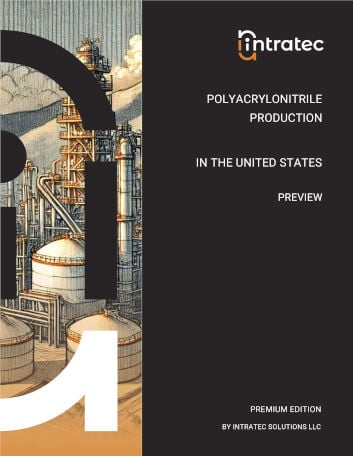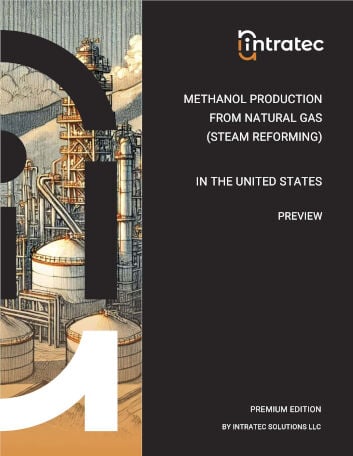Commodity Production Costs Report
Methyl Acrylate Production
Methyl Acrylate Plant Capital & Operating Cost Analysis | United States | Q2 2025
This report presents the economics of Methyl Acrylate production from acrylic acid and methanol. The process examined is similar to the Synthomer process. In this plant, acrylic acid and methanol are esterified in a fixed bed reactor, packed with an ion-exchange resin used as strong acid catalyst.
The report provides a comprehensive study of Methyl Acrylate production and related Methyl Acrylate production cost, covering three key aspects: a complete description of the Methyl Acrylate production process examined; an in-depth analysis of the related Methyl Acrylate plant capital cost (Capex); and an evaluation of the respective Methyl Acrylate plant operating costs (Opex).
The Methyl Acrylate production process description includes a block flow diagram (BFD), an overview of the industrial site installations, detailing both the process unit and the necessary infrastructure, process consumption figures and comprehensive process flow diagrams (PFD). The Methyl Acrylate plant capital cost analysis breaks down the Capex by plant cost (i.e., ISBL, OSBL and Contingency); owner's cost; working capital; and costs incurred during industrial plant commissioning and start-up. The Methyl Acrylate plant operating costs analysis covers operating expenses, including variable costs like raw materials and utilities, and fixed costs such as maintenance, labor, and depreciation.

The process examined comprises two main sections: (1) esterification, and (2) purification.
Esterification. Acrylic acid is initially reacted with methanol to produce Methyl Acrylate. Such esterification reaction is carried out in a fixed bed reactor, packed with an ion-exchange resin used as strong acid catalyst. The reactions occur in the liquid phase, and a small excess of methanol is used to improve reaction kinetics and shift the reaction toward the ester formation.
Purification. After the esterification, acrylic acid and heavy by-products formed by the reaction are separated from the esterification product and recycled. The unreacted methanol is also extracted from the crude ester, distilled, and recycled. A final distillation removes the impurities from the product, yielding 99.5% pure Methyl Acrylate.
Report in PDF Format
Download & Explore Anytime
Access in Various Devices
Print & Read Comfortably
Share With Co-workers
Up-to-date Report
Professional report based on Q2 2025 economic data, ensuring timely evaluations.
Multiple Use Cases
Ideal for investment screening, feasibility studies, cost estimates, and research planning.
Proven Methodology
Developed using a consistent methodology honed over a decade, ensuring reliable cost analyses.
Report Editions
Content Highlights
Plant Capital Cost Summary
Summary outlining the capital cost required for building the Methyl Acrylate production plant examined.
Plant Capital Cost Details
Detailing of fixed capital (ISBL, OSBL & Owner’s Cost), working capital and additional capital requirements.
Plant Cost Breakdowns
Breakdown of Methyl Acrylate process unit (ISBL) costs and infrastructure (OSBL) costs; plant cost breakdown per discipline.
Operating Costs Summary
Summary presenting the operating variable costs and the total operating cost of the Methyl Acrylate production plant studied.
Operating Cost Details
Detailing of utilities costs, operating fixed costs and depreciation.
Plant Capacity Assessment
Comparative analysis of capital investment and operating costs for different Methyl Acrylate plant capacities.
Production Process Information
Block Flow Diagram, descriptions of process unit (ISBL) and site infrastructure (OSBL).
Process Consumptions
Raw materials and utilities consumption figures, by-products credits, labor requirements
Process Diagrams
Process flow diagrams (PFD), equipment list and industrial site configuration
Could Not Find the Report You Need?
Obtain a Bespoke Report
Get a report targeting the process in which you are interested
See Offer Details
Understand Bespoke Reports and how you can easily order them
Check Editions & Pricing
Complete a brief form and see a quotation for your Bespoke Report
Other Related Production Cost Reports

Acrylic Acid Production from Glycerol
It presents the economics of Ester-Grade Acrylic Acid (EAA) production from crude glycerol in the USA using a two-step process similar to Arkema technology. In the process examined, crude glycerol, obtained from biodiesel plants, is dehydrated to acrolein, which is subsequently oxidized to Acrylic Acid.
Details: 100 kta United States-based plant | Q2 2025 | 107 pages | Issue B | From $799 USD

Methanol Production from Natural Gas (Combined Reforming)
This study presents the economics of large-scale Methanol production from natural gas in the United States. In this process, natural gas is first converted into synthesis gas (syngas) by means of conventional steam reforming and secondary autothermal reforming. Then, the syngas is converted into Methanol.
Details: 1700 kta United States-based plant | Q2 2025 | 107 pages | Issue B | From $799 USD

Acrylic Acid Production from Propylene
This report presents the economics of Ester-Grade Acrylic Acid (EAA) production from chemical grade (CG) propylene in a plant located in the United States. The process consists in a two stage vapor-phase oxidation of propylene, yieding Acrylic Acid, which is then purified to obtain the Ester-Grade product.
Details: 150 kta United States-based plant | Q2 2025 | 107 pages | Issue A | From $799 USD

Polyacrylonitrile Production
This report presents a techno-economic analysis of Polyacrylonitrile (PAN) Precursor production in the United States via aqueous dispersion polymerization of acrylonitrile with methyl acrylate comonomer followed by transformation steps to become a fiber.
Details: 9 kta United States-based plant | Q2 2025 | 107 pages | Issue A | From $799 USD

Methanol Production from Natural Gas (Steam Reforming)
This study presents the economics of large-scale Methanol production from natural gas in the United States. In the process examined, natural gas is first converted into synthesis gas (syngas) by means of conventional steam reforming and then the syngas is converted into Methanol.
Details: 1000 kta United States-based plant | Q2 2025 | 107 pages | Issue A | From $799 USD
+800 Reports Developed, Targeting +250 Commodities
Vast Report Library
858 independent and up-to-date reports examining embryonic and established production processes.
Free Sample Reports
Quickly understand the structure and depth of content of our professional reports.

